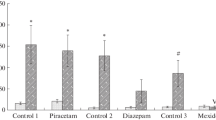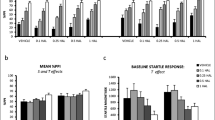Abstract
The effects of chlordiazepoxide and atropine on the acquisition of passive avoidance learning in rats were compared in two superficially similar but theoretically distinct forms of the step down task in an attempt to dissociate behaviourally the disinhibiting effects of these two classes of drug. In a discrete trial procedure both chlordiazepoxide and atropine significantly retarded acquistion; on retention testing under saline treatment alone, the initial chlordiazepoxide group showed no change in behaviour while the initial atropine group showed a facilitation. In a continuous trial procedure, however, atropine but not chlordiazepoxide produced an increase in the total number of step downs; despite this, these groups showed acquisition at similar rates, though learning was not shown on retention testing under saline alone. These results enabled the two classes of drug to be distinguished. The nature of the heterogeneity between the two test paradigms is discussed, and results interpreted in terms of possible differential drug effects on punishment and escape components of the tasks.
Similar content being viewed by others
References
Buresova, O., Bures, J., Bohdanecky, Z., Weiss, T.: Effect of atropine on learning, extinction, retention and retrieval in rats. Psychopharmacologia (Berl.) 5, 205–263 (1964)
Calhoun, W. H., Smith, A. A.: Effects of scopolamine on acquisition of passive avoidance. Psychopharmacologia (Berl.) 13, 201–209 (1968)
Carlton, P. L.: Brain acetylcholine and inhibition. In: Reinforcement: Current research and theories, J. P. Tapp, ed., pp. 286–327 New York: Academic Press 1969
Davies, J. A., Navaratnam, V., Redfern, P. H.: A 24-h rhythm in passive avoidance behaviour in rats. Psychopharmacologia (Berl.) 32, 211–214 (1973)
Di Giusto, E. L.: Adrenaline or peripheral noradrenaline depletion and passive avoidance in the rat. Physiol. Behav. 8, 1059–1062 (1972)
Douglas, R. J.: The hippocampus and behaviour. Psychol. Bull. 67, 416–442 (1967)
Geller, I.: Relative potencies of benzodiazepines as measured by their effects on conflict behaviour. Arch. int. Pharmacodyn. 149, 243–247 (1964)
Hanson, H. M., Witoslawski, J. J., Campbell E. A.: Drug effects in squirrel monkeys trained on a multiple schedule with a punishment contigency. J. exp. Anal. Behav. 10, 565–569 (1967)
Margules, D. L., Stein, L.: Neuroleptics vs. tranquillizers: evidence from animal behaviour studies of mode and site of action. In: Neuro-psychopharmacology, H. Brill, J. O. Cole, P. Deniker, H. Hippius, and P. B. Bradley, eds., pp. 108–120. Amsterdam: Excerpta Medica Foundation 1967.
Meyers, B.: Some effects of scopolamine on a passive avoidance response in rats. Psychopharmacologia (Berl.) 8, 111–119 (1965)
Miczek, K. A.: Effects of scopolamine, amphetamine and chlordiazepoxide on punishment. Psychopharmacologia (Berl.) 28, 373–389 (1973)
Miczek, K. A., Lau, P.: Effects of scopolamine, physostigmine and chlordiazepoxide on punished and extinguished water consumption in rats. Psychopharmacologia (Berl.) 42, 263–269 (1975)
Oishi, H., Iwahara, S., Yang, S., Yogi, A.: Effects of chlordiazepoxide on passive avoidance responses in rats. Psychopharmacologia (Berl.) 23, 373–385 (1972)
Overton, D. A.: State-dependant learning produced by depressant and atropine-like drugs. Psychopharmacologia (Berl.) 10, 6–31 (1966)
Sachs, E., Weingarten, M., Klein, N. W.: Effects of chlordiazepoxide on the acquisition of avoidance learning and its transfer to the normal state and other drug conditions. Psychopharmacologia (Berl.) 9, 17–30 (1966)
Siegal, S.: Non-parametric statistics for the behavioural sciences. New York. McGraw-Hill 1956
Zbinden, G., Randall, L. O.: Pharmacology of benzodiazepines: laboratory and clinical correlations. Advanc. Pharmacol. 5, 213–291 (1967)
Author information
Authors and Affiliations
Rights and permissions
About this article
Cite this article
Waddington, J.L., Olley, J.E. Dissociation of the anti-punishment activities of chlordiazepoxide and atropine using two heterogeneous passive avoidance tasks. Psychopharmacology 52, 93–96 (1977). https://doi.org/10.1007/BF00426606
Received:
Accepted:
Issue Date:
DOI: https://doi.org/10.1007/BF00426606




